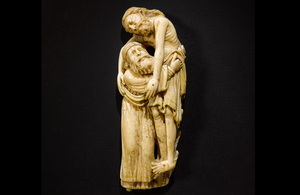Walrus ivory carving of Deposition from the Cross at risk of leaving the UK
A temporary export bar has been placed on a walrus ivory carving of the Deposition from the Cross so a domestic buyer can be found.

- A temporary export bar has been placed on a walrus ivory carving of the Deposition from the Cross
- The Romanesque carving is valued at over £2 million
- Export bar will allow time for a UK gallery or institution to acquire the carving for the nation
A 12th-century English walrus ivory carving depicting the Deposition from the Cross is at risk of leaving the UK unless a domestic buyer can be found.
The Romanesque carving, which is valued at £2,006,595 (plus VAT of £40,131.90), is made of walrus ivory and depicts the moment in the story of the Passion of Christ known as the Deposition from the Cross, in which Jesus’s body is lifted down from the cross by Joseph of Arimathea. It would once have been part of a larger scene and would have included a cross which is still partly visible and other figures.
The work is particularly relevant for our understanding of early mediaeval ivories. It is already well-known to the national and international research communities into Romanesque sculpture, and into mediaeval art more widely.
Arts and Heritage Minister Lord Parkinson of Whitley Bay said:
As well as being an object of great reverence and accomplishment, this exquisite 12th-century carving is significant to our understanding of ivories in the early mediaeval period.
I hope that a UK buyer will come forward so that this work can be saved for the nation and studied and admired by generations to come.
The Minister’s decision follows the advice of the Reviewing Committee on the Export of Works of Art and Objects of Cultural Interest.
The Committee made its recommendation on the basis that the carving met the first, second and third Waverley criteria for its outstanding connection with our history and national life; its outstanding aesthetic importance; and its outstanding significance for the study of early mediaeval ivories. It was noted that the work was one of the most culturally and aesthetically significant objects they have considered, and that it could provide vital insight into several aspects of a time from which few objects have survived.
Committee Member Tim Pestell said:
This mediaeval ivory depiction of the Deposition of Christ is a truly remarkable object, both for its early date and its sublimely skilful carving. Delicately observed and showing dignified restraint in its depiction of the dead Christ, it represents one of the finest surviving examples of English Romanesque ivory carving. This rarity means we have much to learn from it, ranging from examining its artistic design and the workshop that produced it, to scientific investigation of the walrus ivory it is made of that might tell us about mediaeval exploitation of the environment, and trade and exchange networks.
I earnestly hope that a UK museum can now be found to acquire this stunning and nationally-significant carving where it can be placed on public display, be suitably contextualised and made available for the detailed research it so richly deserves.
The decision on the export licence application for the carving will be deferred for a period ending on 2 February 2024 (inclusive). At the end of the first deferral period owners will have a consideration period of 15 Business Days to consider any offer(s) to purchase the carving at the recommended price of £2,006,595 (plus VAT of £40,131.90 which can be reclaimed by an eligible institution). The second deferral period will commence following the signing of an Option Agreement and will last for four months.
Notes to editors
-
Organisations or individuals interested in purchasing the carving should contact the RCEWA on 02072680534 or rcewa@artscouncil.org.uk.
-
Details of the carving are as follows: Deposition from the Cross, about 1190-1200, England (probably York), carved walrus ivory, 18.3 x 6.8 x 3.4 cm
-
Provenance: John and Gertrude Hunt, Dublin; Hence by descent:
-
The Reviewing Committee on the Export of Works of Art and Objects of Cultural Interest is an independent body, serviced by Arts Council England (ACE), which advises the Secretary of State for Culture, Media and Sport on whether a cultural object, intended for export, is of national importance under specified criteria.
-
It is illegal to deal in items containing or made of elephant ivory, unless they are registered as exempt or certified as exempt, under the Ivory Act 2018. The Government has announced that it will extend the ban on dealing to five other species, including Walrus ivory, but this has not yet been enacted.
-
Arts Council England is the national development agency for creativity and culture. Its strategic vision in Let’s Create is that, by 2030, England should be a country in which the creativity of everyone is valued and given the chance to flourish and where everyone has access to a remarkable range of high-quality cultural experiences. ACE invests public money from the Government and the National Lottery to support the sector and deliver the vision. Following the Covid-19 crisis, ACE developed a £160 million Emergency Response Package, with nearly 90 per cent coming from the National Lottery, for organisations and individuals needing support. It is also one of the bodies administering the Government’s unprecedented £1.5 billion Culture Recovery Fund.